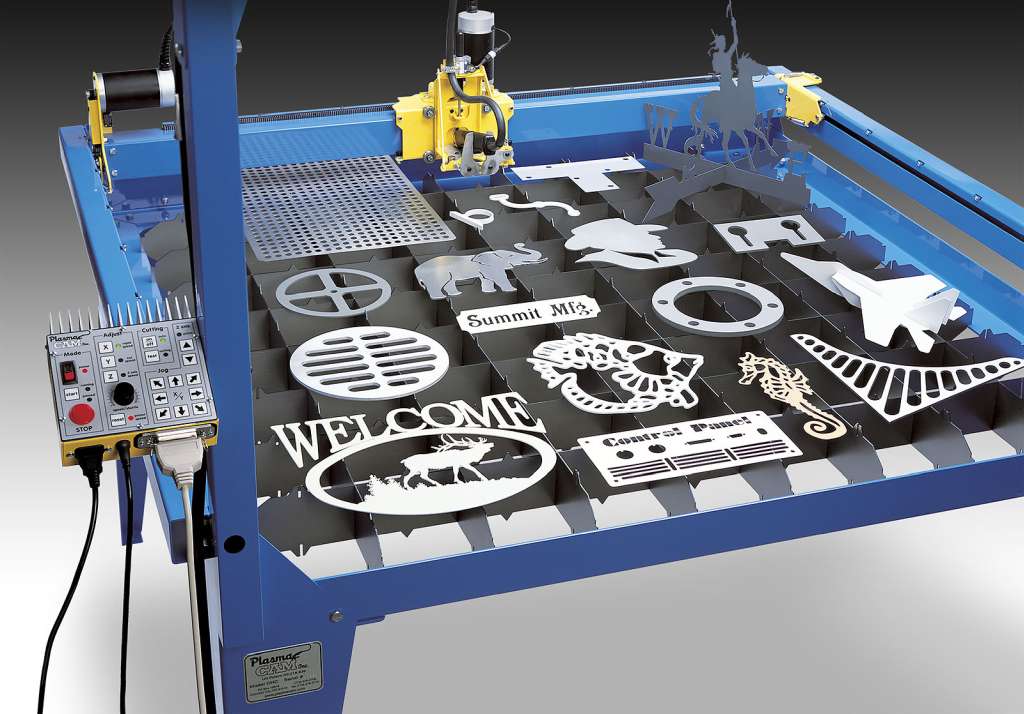What is a CNC Robotic Cutting System? Our PlasmaCAM machine cuts flat shapes out of metal with incredible precision and speed.

What is a CNC Robotic Cutting System Used For?
A CNC (Computer Numerical Control) robotic cutting system is a powerful and highly automated tool used in various industries to perform precision cutting tasks on a range of materials. Combining the capabilities of CNC technology with robotic arms, these systems offer unparalleled accuracy, efficiency, and versatility. From metal fabrication to woodworking, CNC robotic cutting systems have become a cornerstone of modern manufacturing, streamlining production processes and improving output quality.
The Basics of CNC Technology
CNC technology refers to the computerized control of machine tools and equipment. In a CNC system, a computer translates digital design files into instructions, which are then executed by the machine. These instructions typically govern the movement, speed, and operation of cutting tools, ensuring that complex shapes and designs are accurately produced with minimal human intervention.
A robotic cutting system adds another layer of automation, replacing manual operations with robotic arms that precisely control the movement of cutting tools. This combination allows for intricate cuts, repeatability, and consistency that are difficult to achieve with traditional methods.
How CNC Robotic Cutting Systems Work?
A CNC robotic cutting system consists of several key components:
1. **Robotic Arm:** This serves as the primary manipulator, guiding the cutting tool with exceptional precision. The robotic arm can rotate and move in multiple axes, giving it the ability to handle complex cuts from various angles.
2. **Cutting Tool:** Depending on the material and application, the system can be equipped with different cutting tools, such as plasma torches, lasers, water jets, or milling heads. These tools interact with the material to perform cuts as per the design specifications.
3. **Control Unit:** The control unit houses the CNC software, which interprets design files (usually in CAD/CAM formats) and translates them into specific instructions for the robotic arm and cutting tool.
4. **Material Bed or Work Area:** This is where the material to be cut is placed. The robotic arm moves around or over this area, depending on the setup, to execute the cutting process.
Applications of CNC Robotic Cutting Systems.
1. **Metal Fabrication:**
One of the primary industries where CNC robotic cutting systems shine is metal fabrication. Whether for cutting steel plates, aluminum sheets, or stainless steel tubing, these systems deliver high precision and consistency. CNC robotic plasma cutting, for instance, is commonly used in industries such as automotive, aerospace, and construction, where accurate and complex cuts are essential.
2. **Woodworking and Carpentry:**
In woodworking, CNC robotic cutting systems allow craftsmen to create intricate designs, engravings, and furniture parts with speed and accuracy. Automated systems reduce human error, and their ability to work on multiple axes allows for more creative freedom in design.
3. **Textiles and Leather:**
CNC robotic cutting systems have found applications in the textile and leather industries, where they are used to cut fabrics and leather for clothing, upholstery, and accessories. The precision offered by CNC ensures minimal waste, making it an economical choice for mass production.
4. **Plastics and Composites:**
The ability of CNC systems to handle delicate materials like plastics and composites makes them ideal for industries such as packaging, electronics, and medical equipment manufacturing. CNC robotic laser cutting is frequently used for intricate parts made from these materials.
What are the Advantages of CNC Robotic Cutting Systems?
– **Precision and Accuracy:** Robotic arms ensure that the cutting tool follows the exact path dictated by the digital design, resulting in superior precision.
– **Automation and Efficiency:** With minimal human intervention required, CNC robotic systems can operate continuously, boosting productivity and reducing labor costs.
– **Versatility:** These systems are highly adaptable and can work on a wide range of materials, making them suitable for diverse industries.
– **Reduced Waste:** By optimizing cuts through software, material usage is minimized, contributing to cost savings.
In Conclusion
At Montana Metalwork’s and Signs. Our CNC robotic cutting system is at the forefront of modern manufacturing, offering unmatched precision, efficiency, and versatility.
Whether in metal fabrication, woodworking, textiles, or plastics, these systems have become indispensable for businesses looking to enhance productivity and product quality.
As technology continues to advance, the role of CNC robotic cutting systems will likely expand, driving innovation across numerous industries.
